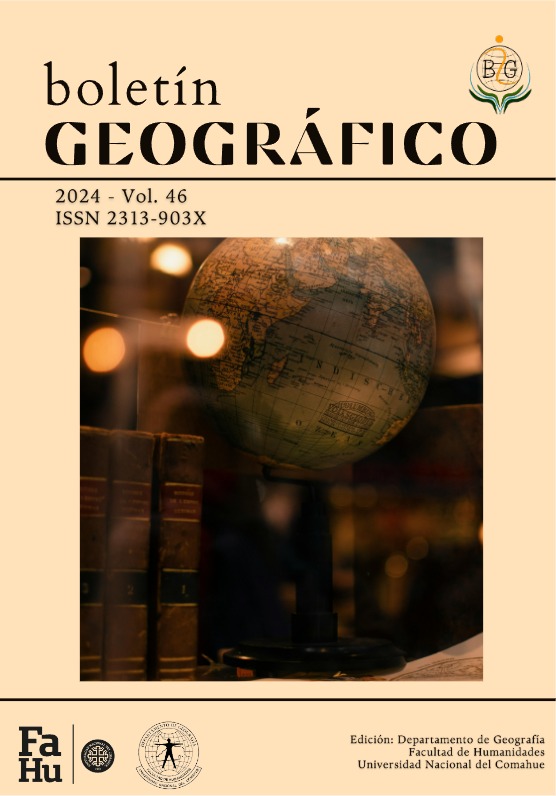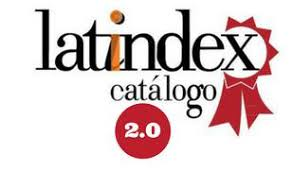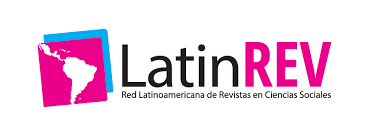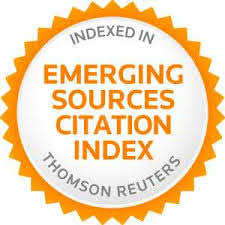25 de Mayo, a city on edge due to pollution in the Colorado River
Keywords:
25 de Mayo, saneamiento, efluentes cloacales, desarrollo, participaciónAbstract
Colorado River is the main watercourse of its homonymous basin, located mostly in Northern Patagonia, being at the same time the natural limit between the provinces of Río Negro and La Pampa. Because it has a snow regime, which drains to the Atlantic, it allows the supply of fresh water in sufficient quantities for its various uses and exploitations. This has a particular geographical imprint, given that the resource is capable of providing the supply of drinking water beyond the riverside localities, within an eco-regional and climatic context marked by aridity. However, over the years, economic activities have increased and, with them, urbanizations where a sustainable management of water resources was not implemented.
In this context, upstream of La Pampa towns there is the discharge of wastewater and the drainage of oil spills or other economic activities, such as mining. For this reason, the city of 25 de Mayo denotes sources of pollution after its almost exponential growth, associated with the hydrocarbon boom that occurred at the end of the last century. Not only were incidents linked to extreme flow oscillations (river floods and droughts) not resolved. Different problems caused by the actions of oil companies and others were also not reversed and, despite its projection, a sewage treatment plant was never built in accordance with the population increase. In fact, this sewage is discharged into the river, believing that the solids settle over after twenty kilometers, until it drains. However, there are previous studies in Casa de Piedra tourist village, beyond the dam, where it has been found that pollution, both from oil spills and sewage discharges, does not disappear downstream. And this affects, among other water uses, the main aqueduct of La Pampa.
Given this problem, the research aimed to verify whether the environmental indicators were persistent towards the year 2023 and, likewise, which alternatives or proposals are more sustainable. To do this, sampling was carried out downstream of 25 de Mayo, in order to compare the environmental situation. This included physical-chemical and bacteriological analyzes of water and arthropods (bioindicators), added to participant observations and interviews with key informants (Delphi System), in order to understand the multicausalities or intervening factors.
After the results in two laboratories, contamination was confirmed in those drains in contact with the river and in the course mentioned. This aggravates the previous situation upstream, mainly derived from the oil hub located in Rincón de los Sauces (Neuquén). At the same time, the dumping of other waste was detected from rural properties and homes located on the riverside strip, installed temporarily or informally. Finally, through consultations with experts in the field and a meeting among the participating team, it was agreed that in addition to requiring a new treatment plant, it is necessary to divert the treated water to forestry or other related uses, which would contribute positively to the productive area, and even to public plantation of trees.
Downloads
References
Aumassanne, A. (2019). Variaciones del caudal del río Colorado en su curso medio. Período 2010-2018. 25 de Mayo, L.P.: Agencia de Extensión Rural de INTA en 25 de Mayo.
Betelú, M.; Altolaguirre, L.; Pereyra Fernández, E. & Lapena, J. (2022). Curso medio del río Colorado: Antecedentes de la gestión del riesgo ante escenarios críticos previsibles. En VI Congreso Pampeano del Agua. S. Rosa: Sec. Rec. Hídricos de La Pampa-UNLPam.Chiozza, E. y Figueiras, R. (1982). Atlas físico de la Rep. Argentina. Vol. 1 y 2. CABA: CEAL.
Castro, E. y Lapena, J. (2018). Problemas irresueltos, pese a las costosas obras de abastecimiento de agua potable en La Pampa. En XIV Congreso Argentino de Hidrogeología. Salta: UN Salta.
Cazenave, H.W. (2017). Casa de Piedra: efectos de las aguas claras en la hidrografía del río Colorado. Boletín geográfico, 39, 109-125.
Ceballos, L. (2023). Resultados del muestreo de agua superficial, efluentes y red de agua realizado en colonia 25 de Mayo, La Pampa. Informe Técnico de Impacto Ambiental. Santa Rosa: Honorable Cámara de Diputados de la provincia de La Pampa.
CFI (2013). Control de calidad en plantas de tratamiento de efluentes cloacales de la provincia de La Pampa 2013. Recuperado de: http://biblioteca.cfi.org.ar/documento/control-de-calidad-en-plantas-de-tratamiento-de-efluentes-cloacales-de-la-provincia-de-la-pampa
Daniele C. y Natenzon, C. (1988). Las regiones naturales de la Argentina: Caracterización y diagnóstico. CABA: Eudeba.
Dillon, B. (2013). Territorios empetrolados. Geografías del Suroeste de La Pampa en la ribera del río Colorado. Santa Rosa: EdUNLPam.
Dillon, B., Comerci, M. E.; Leticia García, L. y Soncini, J. (2012). Estudio para la cuantificación monetaria del daño causado a la provincia de La Pampa por la carencia de un caudal fluvioecológico del río Atuel. Informe final, Tomo II, Vol. 3. S. Rosa: Ed. UNLPam.
EPRC, Ente provincial del Río Colorado (2021). Plan de riego Anual Campaña 2021-22. Recuperado de: https://enteriocolorado.lapampa.gob.ar/images/Archivos/requerimientos_hidricos/Informe_y_Planilla_Necesidad_de_riego_Noviembre_2021.pdf
Fontanella, D. (2022). Desafíos para la reconversión de un sistema de riego gravitacional a presurizado. En VI Congreso Pampeano del Agua. S. Rosa: Sec. Rec. Hídricos y UNLPam.
Golberg, A. (2015). La Pampa y sus ríos. Santa Rosa: Fundación Chadileuvú.
INTA, INA y la CONAE, (2023). Tras 12 años de sequía, estudian la cuenca hídrica del río Colorado. Recuperado de: https://www.argentina.gob.ar/noticias/tras-12-anos-de-sequia-estudian-la-cuenca-hidrica-del-rio-colorado
Lapena, J. (2021). Biogeografía argentina. En Velázquez y Celemín: Configuración y reconfiguración socioterritorial de la Argentina en tiempos del bicentenario. Tandil: IGEHCS.
Lapena, J. y García, M. C. (2016). “Problemas ambientales y retracción económica en Patagonia. Pedro Luro y cuenca inferior del río Colorado”. En Cadiz y Brouchoud: Contradicciones de desarrollo y horizontes alternativos. XI Jornadas Patagónicas de Geografía. Neuquén: Unco.
MJN, Ministerio de Justicia de la Nación (1994). Ley Nacional N° 25.675: Ley General del Ambiente. CABA: Sec. Pres. de la Nación.
Organización de las Naciones Unidas (2010). Derecho universal al agua potable y al saneamiento. Res. A/RES/64/292. N. York, EE.UU.: Asamblea de las Naciones Unidas.
Pereyra Fernández, E.; Fernández, E.; Lapena, J. y Betelu, M. (2023). Riesgos y problemas ambientales en la Villa Turística Casa de Piedra, La Pampa, Argentina. Huellas, 27, 95-115.
Romani, C. (2021). General Pico: prospectiva territorial de un escenario hídrico deficiente. En tesis de grado. UNLPam, Santa Rosa, Argentina.
Strahler, A. y Strahler, A. (1994). Geografía Física. Barcelona, Omega.
Subsecretaría de Recursos Hídricos de la Nación (2015). Estadística Hidrológica de la República Argentina. Edición 2015. CABA: Ministerio de Obras Públicas de la Nación.
Kazmann, N. (1979). Hidrología moderna. México DC: CECSA.
Fuentes de divulgación
La Mañana, Diario (2014). Otro derrame de petróleo en Rincón de Los Sauces. Edición del día 27/7/14. Recuperado de: https://www.lmneuquen.com/otro-derrame-petroleo-rincon-n231118
La Arena, Diario (2009). La Pampa: 25 de Mayo también vierte sus efluentes cloacales al Colorado. Edición del día 24/09/09. Recuperado: https://intra.ada.gba.gov.ar/intra/infoagua/200909/noticias/278914.html
La Arena, Diario (2023). Maquieyra habló del Colorado y le dijeron "ignorante". Edición del día 07/01/2023. Recuperado de: https://www.laarena.com.ar/la-pampa/hablo-del-colorado-y-le-dijeron-ignorante--2023170280
Radio Don, FM (2023). Maquieyra denunció que 25 de Mayo arroja los líquidos cloacales en el río Colorado. Edición del 01/06/23. Recuperado de: https://radiodon.com.ar/2023/01/06/maquieyra-denuncio-que-25-de-mayo-arroja-los-liquidos-cloacales-en-el-rio-colorado/
Región, Semanario (2021). Abeldaño, 25 de Mayo: Destacan el trabajo de salud y política de viviendas. Edición 17/06/21. Recuperado de https://www.region.com.ar/productos/semanario/archivo/noticias-la-pampa/abeldano-destaco-trabajo-salud-1449.html
Published
How to Cite
Issue
Section
ARK
License
Copyright (c) 2024 Boletín GeográficoTransfer of rights and data processing
The acceptance of an article for publication in the Journal Geographic Bulletin implies the cession of the rights of printing and reproduction, by any means and means, of the author in favor of the Department of Geography of the National University of Comahue, which will not reject any request reasonable for the authors to obtain permission to reproduce their contributions. The total or partial reproduction of the works published in the Geographic Bulletin must be done citing the origin, otherwise, the copyright is violated.
Likewise, it is understood that the concepts and opinions expressed in each work are the sole responsibility of the author, without being responsible or in solidarity, necessarily, neither the editorial staff nor the editorial staff.
It is the responsibility of the authors to be able to provide interested readers with copies of the raw data, procedure manuals, scores and, in general, relevant experimental material.
Likewise, the Management of the journal guarantees the appropriate treatment of personal data
COPYRIGHT TRANSFER FORM

















 Journal of the
Journal of the 